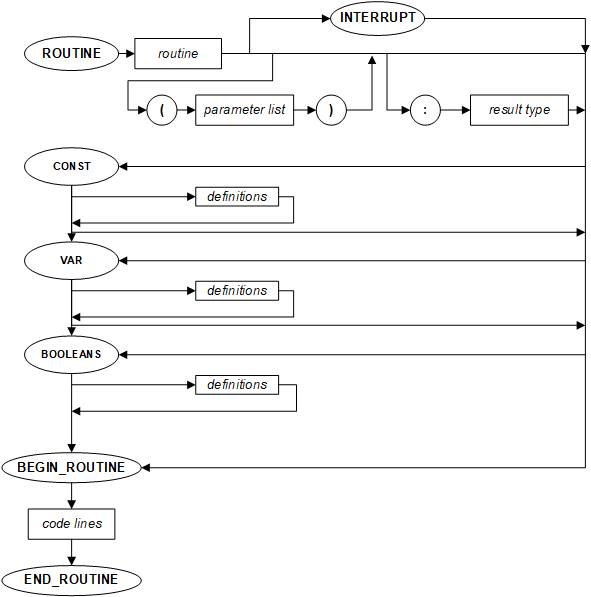ROUTINE...BEGIN_ROUTINE...END_ROUTINE
For Routines as part of a Class see Class ROUTINE.
Syntax
Command
Mandatory parameter Optional parameter Mandatory keyword Optional keyword |
ROUTINE <Routine> [INTERRUPT | [(<Parameter list>)][ :
<Resulttype>]]
[CONST
<Definitions>]
[VAR
<Definitions>]
[BOOLEANS
<Definitions>]
BEGIN_ROUTINE
<Code lines>
END_ROUTINE
Description
Defines a routine.
Diagram

Returned value type
Depends on the <result type> definition
Parameters
| Parameter | Description | |
| <Routine> | Name of the routine. This cannot be a name that is already used for a Form, Report or Global Routine. | |
| INTERRUPT |
Allows the end user to interrupt other routines within the same Report. In the Control Center, the interrupt can be invoked and its value (0 - 99) can be set, which will be
stored in the system item SI-REPORTRESULT at the time
that the "interrupting routine" is executed. |
|
| <Parameter list> |
List of declarations. Unless for constant declarations, the parameters (fields) that are
specified in this list can be invoked directly through a Routine-Call. To each specified parameter a
type and a length have to be assigned. If multiple variables have the same type and length, you may
declare these variables together instantly. You may also specify the options VAR or CONST, which are
comparable with these specifications for definitions inside the routine. The syntax for specifying the
declarations is the following: [VAR | CONST] <Field specification> [:] <Type> <Length> [OPTIONAL] |
|
| VAR | Declares that the specified fields are variables to be called by reference. When using this option, the
following rules apply:
|
|
| CONST | Declares that the specified fields are constants. When using this option, fields are treated as readonly and therefore cannot be changed through the calling routine. | |
| <No type definition> | When no type definition is given, the parameter will be available as variable inside the procedure, but changes to its value will only effect the local variable. | |
| <Field specification> | Specification of one or more field names. When declaring multiple fields at once, you have to use the comma (,) as a separator. This way, these fields will instantly be defined with the same characteristics. It is possible to use DCT in variable declarations in the routine header, e.g.:
routine new_travelnr (sa-travelnr dct travelnr)
|
|
| <Type> | The type of the variable(s), which may be ALPHA, NUMERIC, BOOLEAN, STRING, INTEGER, SIGNED, FINANCIAL, PRINTER (for text reports) or PRINTERGRAPHICAL (for graphical reports). | |
| <Length> | The maximal length of the specified variable(s). This parameter only has to be specified if the type is ALPHA or NUMERIC. The number of decimals are supplied after a dot. | |
| OPTIONAL |
When specified this parameter can be omitted in the call to the routine. This can only be used for the
last (consecutive) parameters in the parameter list. |
|
| <Resulttype> | Type that is returned after the routine has ended. Also the DCT can be used.
routine new_travelnr (sa-travelnr alpha 19) : dct travelnr
routine new_travelnr (sa-travelnr dct travelnr) : dct travelnr
|
|
| CONST | Declares that the next <Definitions> defines constants that can only be used locally inside the routine. | |
| BOOLEANS | Declares that the next <Definitions> defines a boolean function | |
| VAR | Declares that the next <Definitions> defines variables that can only be used locally inside the routine. | |
| <Definitions> | Definitions for constants or variables that are used in the program. To make it possible to call multiple variables at once locally, variables can be defined within a structure. | |
| <Code lines> | Code lines that are executed within the routine. | |
Remarks
Parameters for the routine are defined in the <Parameter list>.
Optionally, you may specify a <Result type>. The value of the variable result will then be returned as return value.
After the routine definition header the definitions of the constants (CONST part) are specified, followed by the variable definitions (VAR part).
The instructions that must be executed when the routine is called, are specified between the keywords BEGIN_ROUTINE and END_ROUTINE.
There are some routines that are automatically added to an object, which are:
- DISPLAY_MAIN (forms only); which is the routine that is started automatically when the form is called.
- PROCESS_MAIN (forms only); which is the routine that is started automatically when the form is sent.
- MAIN (only for Global Routines and Reports); which is the routine that is started automatically when calling the object in which it is defined.
A routine that is defined within a form or report may only be called locally. Global routines may also be called from other objects in the same application. If the routine is part of a dll file, it may be called from an external program by using the CALL instruction.
Example
begin_routine
if printable
print (lay_05)
result := true
else
result := false
endif
end_routine
